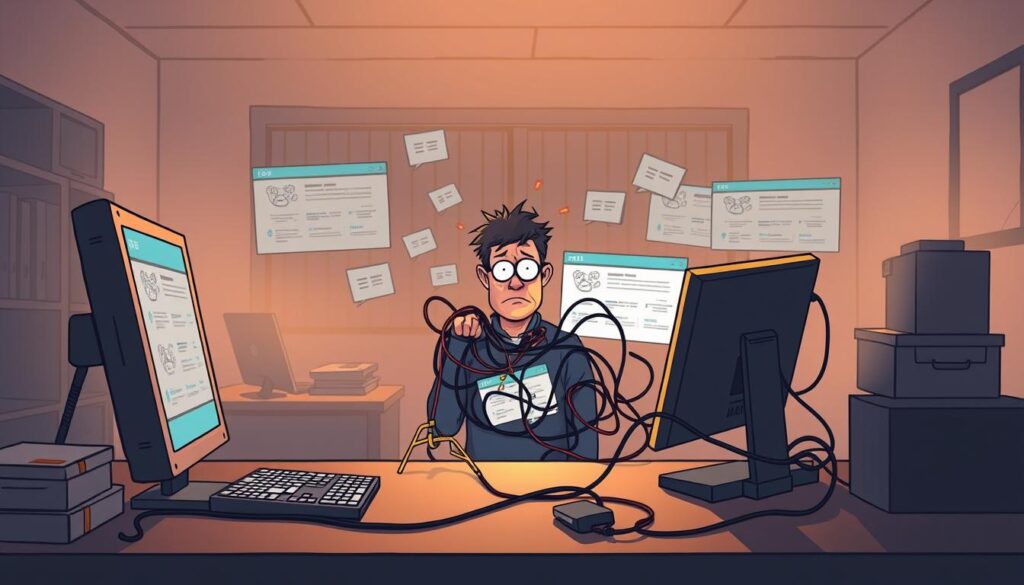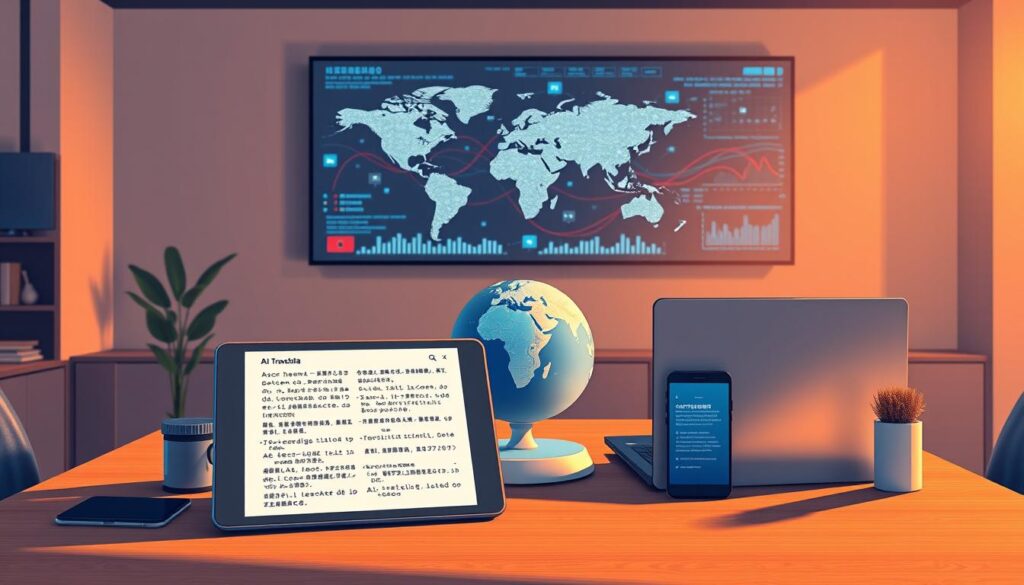In today’s connected world, breaking down language barriers is more important than ever. Advanced technologies are transforming how we communicate, making it easier for businesses and individuals to connect across borders.
These tools are not just about convenience. They open up opportunities for growth, collaboration, and innovation. For example, Google Translate supports over 130 languages, helping millions every day.
By saving time and resources, these solutions are changing the way we interact. Whether you’re a traveler, entrepreneur, or part of a remote team, these advancements are here to stay.
What is AI-Powered Translation and How Does It Work?
The way we translate text has seen groundbreaking advancements in recent years. From clunky word-for-word systems to sophisticated artificial intelligence-driven tools, the evolution has been remarkable. These translation tools now rely on machine learning and neural networks to deliver more accurate and natural results.
The Evolution of Translation Technology
Early translation tools were limited to simple word replacements, often producing awkward or incorrect results. Think of the first versions of Google Translate. They lacked context and struggled with complex language structures. However, the introduction of neural machine translation (NMT) changed everything.
NMT systems analyze entire sentences, not just individual words. This approach allows for context-aware translations that sound more natural. For example, Google Neural Machine uses deep learning to understand patterns in vast datasets, improving accuracy over time.
How Neural Machine Translation (NMT) Works
NMT relies on machine learning models trained on massive amounts of text data. These models learn to recognize patterns and relationships between words, phrases, and sentences. The result is translations that mimic human-like fluency.
Tools like DeepL have taken this innovation further, offering translations that are often indistinguishable from those done by humans. Additionally, platforms like D-ID’s AI Video Translate clone voices and sync lip movements, making multilingual videos seamless.
By leveraging artificial intelligence and research, these translation tools are transforming how we communicate across language barriers. Whether you’re translating a document or a video, the technology ensures clarity and precision.
Why AI-Powered Translation is a Game-Changer for Global Communication
Modern technology is reshaping how we connect across the globe. With tools that break down language barriers, businesses and individuals can now communicate more effectively than ever before. These advancements are not just about convenience—they’re transforming industries and creating new opportunities.
Breaking Down Language Barriers for Businesses
For businesses, AI-driven tools are a game-changer. They streamline cross-border negotiations, hiring, and project launches. For example, 70% of companies using these services report faster international project rollouts. This efficiency saves time and resources, allowing teams to focus on growth.
Real-world applications are vast. Multilingual customer support ensures better client relationships. Legal document analysis becomes quicker and more accurate. E-commerce platforms can localize their content to reach global markets seamlessly. Tools like D-ID Video Translate even reduce video localization costs by 80%, making it easier to engage diverse audiences.
Enhancing Accessibility for Individuals
For individuals, these tools open doors to better communication. Instant subtitle translation for videos, like those offered by Moovly and Subtly, makes content accessible to everyone. Real-time speech tools allow users to interact effortlessly across languages.
Platforms like yellow.ai are making a difference in industries like manufacturing and utilities. Multilingual chatbots help blue-collar workers access critical information in their preferred language. This not only improves efficiency but also ensures inclusivity in the workplace.
AI translation is also cost-effective. At $0.10 per word, it’s significantly cheaper than human translation, which averages $0.22 per word. This scalability makes it an ideal solution for both businesses and individuals looking to expand their reach without breaking the bank.
Key Benefits of AI-Powered Translation Hustle: Go Global Without Learning New Languages
Efficiency and speed are at the core of modern communication solutions. Advanced tools are transforming how we handle language needs, making it easier to connect across borders. These services not only save time but also open up new markets for growth.

Cost and Time Efficiency
One of the biggest advantages is cost savings. AI processes 10,000 words in minutes, compared to days for human teams. This efficiency is a game-changer for businesses managing large volumes of content, such as e-commerce product listings or legal documents.
For example, Amazon Translate handles batch translations for enterprises, ensuring quick and accurate results. Hybrid workflows, like BLEND’s localization solutions, combine AI drafts with human editing to reduce errors further.
Scalability and Speed
Scalability is another key benefit. AI translates over 100 billion words daily, far surpassing human capabilities. This makes it ideal for high-volume needs, such as legal discovery or global marketing campaigns.
Microsoft Translator’s integration with Office apps allows seamless document translation, enhancing productivity. Additionally, iTranslate’s offline mode is perfect for travelers and field workers without internet access, ensuring services are always available.
These tools are not just fast; they’re reliable. By leveraging data and advanced algorithms, they deliver precise and natural-sounding results, making them indispensable in today’s connected world.
Challenges and Limitations of AI-Powered Translation
While AI translation tools have made significant strides, they still face notable challenges. Understanding these limitations is crucial for anyone relying on these tools for critical tasks.

Context and Nuance in Language
One of the biggest hurdles is handling context and cultural nuances. Idioms like “break a leg” or region-specific references often trip up AI systems. For example, ChatGPT’s Welsh language glitches highlight how even advanced models struggle with less common languages.
These issues can lead to misunderstandings, especially in sensitive sectors like legal or medical fields. A mistranslation in a contract or medical report could have serious consequences. This is why human oversight remains essential for critical documents.
Ethical Concerns and Bias in AI Translation
Another major concern is bias in data training. AI systems learn from vast datasets, but if these datasets are skewed, the translations can reflect those biases. A PYMNTS case study revealed politically sensitive translations that favored certain narratives over others.
This raises ethical questions, particularly when AI is used in areas like news or legal research. Hybrid models, combining AI with human review, are increasingly seen as a way to mitigate these risks. They balance speed and accuracy while ensuring fairness.
Despite these challenges, the potential for growth is immense. MarketsandMarkets projects the NLP market to reach $35.1 billion by 2026. As tools evolve, addressing these limitations will be key to serving diverse audiences effectively.
Top AI-Powered Translation Tools to Explore
Choosing the right tools can make all the difference in breaking down communication barriers. With so many options available, it’s essential to find the ones that best suit your needs. Whether you’re translating text, localizing content, or engaging with global audiences, these translation tools offer unique features to help you succeed.
Google Translate: The Most Popular Option
Google Translate remains a go-to choice for millions of users. Supporting over 130 languages, it’s a versatile and free solution for quick translations. While it may not always capture nuances perfectly, its accessibility makes it ideal for casual use.
For travelers or students, Google Translate’s mobile app offers offline functionality. This ensures you can work without an internet connection, making it a reliable companion on the go.
DeepL: High-Quality, Natural-Sounding Translations
DeepL is known for its superior fluency, especially in European languages. It supports 30 languages and delivers translations that often sound more natural than other tools. This makes it a favorite among professionals who need precise and polished text.
While DeepL offers a free version, its premium tier provides additional features like document translation. This makes it a strong contender for industries requiring high accuracy.
Microsoft Translator: Versatile and User-Friendly
Microsoft Translator stands out for its seamless integration with other Microsoft services. Features like live meeting captions in Teams and PowerPoint live translations make it a powerful tool for enterprises. Its Azure integration also supports bulk API-driven workflows, ideal for large-scale projects.
For businesses looking to streamline multilingual communication, Microsoft Translator offers a comprehensive solution. Its versatility ensures it meets the needs of diverse users.
Niche tools like D-ID for video dubbing and Spines for self-published authors also deserve attention. These tools cater to specific needs, such as expanding to LATAM or Asia markets. Whether you’re a traveler using iTranslate or a YouTuber leveraging Subtly, there’s a solution for every scenario.
The Future of AI-Powered Translation
The future of translation lies in real-time and hybrid solutions. As technologies evolve, they are transforming how we interact across world borders. From instant speech-to-text conversions to seamless video dubbing, these advances are making communication more accessible than ever.
Real-Time Speech and Video Translation
Real-time translation is becoming a game-changer. Tools like D-ID now offer lip-syncing for 30 languages, making multilingual video content feel natural. Imagine attending a global conference where every speaker’s words are instantly translated and synced to their lip movements. This innovation is not just convenient—it’s revolutionary.
Emerging technologies like AR glasses are also on the horizon. These devices could overlay instant subtitles for tourists or diplomats, breaking down communication barriers in real-time. Such tools are set to redefine how we experience the world.
Hybrid Approaches: Combining AI with Human Expertise
While AI is powerful, human expertise remains essential. Hybrid models, like BLEND’s, combine AI efficiency with the nuanced understanding of 120+ language experts. This approach ensures accuracy, especially in fields like literature or marketing where tone and cultural context matter.
For example, Coca-Cola’s “Open Happiness” slogan required cultural adaptation for different markets. AI can assist in such creation processes, but human oversight ensures the message resonates locally. By 2027, Gartner predicts 60% of enterprises will adopt these hybrid models, balancing speed and precision.
As challenges like bias and context awareness persist, collaboration between AI and humans will be key. Together, they unlock opportunities for more inclusive and effective global communication.
Conclusion
Breaking down communication barriers has never been easier, thanks to advanced solutions. These tools empower entrepreneurs, authors, and multinational teams to connect seamlessly across language divides. For error-sensitive projects, adopting hybrid strategies—like combining AI drafts with human polish—ensures accuracy and quality.
Platforms like DeepL and BLEND offer a balance of speed and precision, making them ideal for localization. Whether you’re managing content for social media, enhancing customer support, or collaborating across borders, these services save time and resources.
Start exploring these opportunities today. With the right tools, you can expand your reach and thrive in a connected world—no language degree required.
